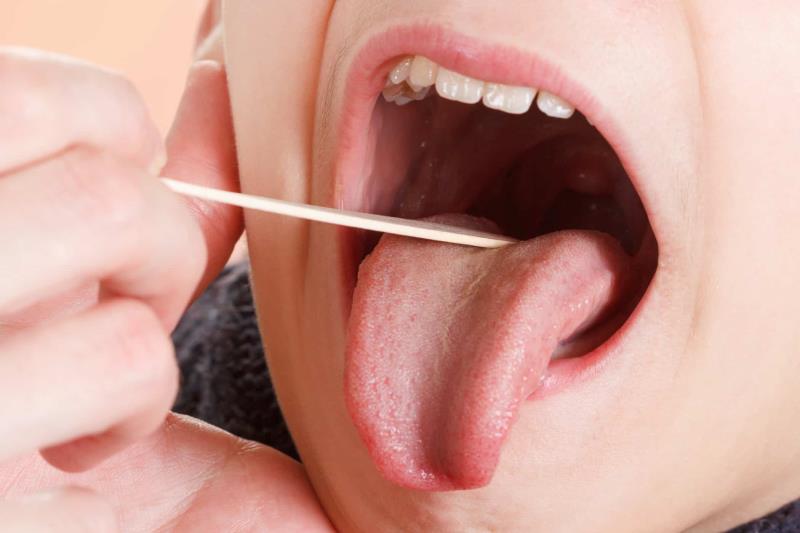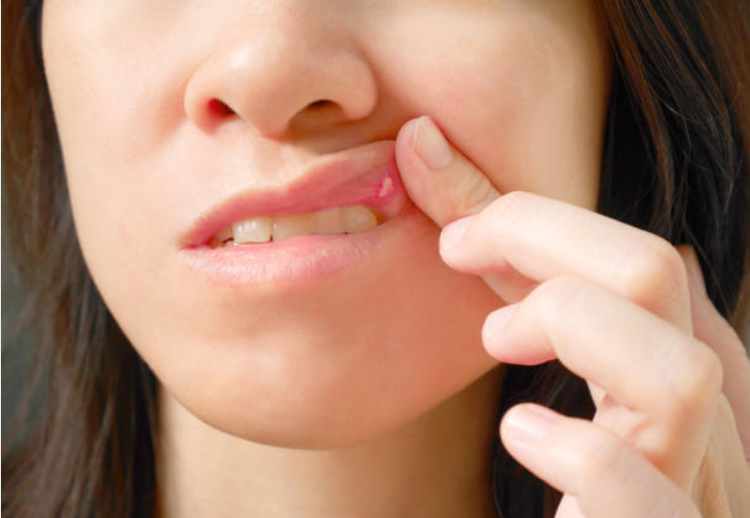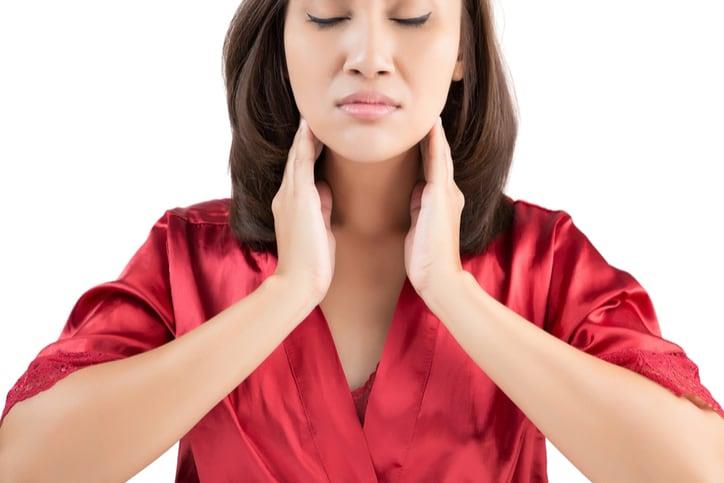8 causes of a sore throat on one side that you need to know

A one-sided sore throat is a problem that anyone can experience. However, not many people fully understand the causes and treatment of this condition.
Let's find out the 8 most common causes of a sore throat on one side and how to treat them in the following article.
Causes of a sore throat on one side
A unilateral sore throat can have many causes, including:
1. Postnasal drip
Postnasal drip is a condition in which mucus drains from the back of the nose. People with postnasal drip often feel like mucus has built up inside the throat.
Glands in the nose and throat normally produce 1-2 liters of mucus per day. However, if you have an infection or an allergy, your body will produce more mucus than usual. When it can't get out properly, mucus runs down your throat and makes you feel uncomfortable.
Postnasal drip often irritates the throat and causes pain. The pain can occur on one side of the throat, especially after you wake up in a side-sleeping position. To treat this condition, you can use certain decongestants, such as pseudoephedrine.
2. Tonsillitis
Tonsillitis is a common disease that occurs in all subjects, usually due to infection. Sometimes the inflammation affects only one tonsil, leading to a unilateral sore throat.

In addition, tonsillitis has other symptoms, including:
- Fever
- Halitosis
- Nasal congestion and runny nose
- Swollen lymph nodes
- The tonsils are red and swollen with pus
- Difficulty swallowing
- Headache
- Stomachache
- There is a bleeding in the tonsils
Usually, viral tonsillitis will clear up on its own within 10 days. To relieve a sore throat, you can use over-the-counter (OTC) pain relievers or home remedies, such as gargling with salt water. In the case of bacterial tonsillitis, your doctor will prescribe you some antibiotics to treat it.
3. Abscess around the tonsils
A peritonsillar abscess is a serious infection that forms a pocket of pus around a tonsil. It is often a complication of strep throat or bacterial tonsillitis.
This condition causes painful sensations on both sides of the throat. However, the pain will be worse on the affected side of the tonsils. For example, an abscess around the right tonsil is likely to cause a sore throat on the right side. Conversely, if the abscess is around the left tonsil, you usually have a sore throat on the left side. Other symptoms of a peritonsillar abscess include:
- Fever
- Tired
- Difficulty speaking
- Pain in the affected ear
- Halitosis
- Drooling
- Hoarseness
Abscesses around the tonsils require immediate medical attention. The doctor will use a needle or make a small incision to drain pus from the affected area. Your doctor can then prescribe an antibiotic for you.
4. Mouth sores
Canker sores are the formation of small sores inside the mouth. Sores can appear on the inside of the cheeks, on or under the tongue, inside the lips, or on the roof of the mouth at the back of the throat. Most ulcers are small, round in shape with a red border, and the center is usually white or yellow.

Despite their small size, they can still cause you a burning sensation. Sores that form in one corner of the back of the throat can cause a unilateral sore throat.
Mouth sores usually clear up on their own within 2 weeks. For pain relief, you can try home remedies or use OTC medications, such as benzocaine.
5. Swollen lymph nodes causing a sore throat on one side
Lymph nodes are responsible for helping the body fight infections. Swollen lymph nodes indicate a problem in your body, such as a viral or bacterial infection. You may easily notice swollen lymph nodes in your neck, under your chin, armpits, or groin.
There are many lymph nodes located in the head and neck area. When they are swollen, you can feel great pain, especially when accidentally touching them. Lymph nodes near the infected area often swell. Just one swollen lymph node is enough to make you feel pain in one side of your throat.
In some cases, swollen lymph nodes can be a sign of a more serious problem, such as cancer or HIV. Therefore, you should contact your doctor when swollen lymph nodes are accompanied by the following symptoms:
- Swollen lymph nodes lasting more than 2 weeks
- Lost weight
- Night sweats
- Prolonged fever
- Tired
- Hard or fast growing lymph nodes
- Swollen lymph nodes located near the collarbone or lower part of the neck
- Skin redness or inflammation at sites with swollen lymph nodes
- Shortness of breath

6. Tongue-pharyngeal and trigeminal neuralgia
Tongue-pharyngeal neuralgia and trigeminal neuralgia are relatively rare conditions. It comes on suddenly, causing intense pain around the ear canal, tongue, tonsils, jaw, or face. These pains usually appear on only one side of the face.
Tongue-pharyngeal neuralgia usually occurs in the back of the throat or tongue. It is usually activated when you swallow and can last from a few seconds to a few minutes.
Trigeminal neuralgia usually occurs in the face or inside the mouth. The pain can be sudden or prolonged with increasing pain intensity. Pain often increases when you touch your face, eat or drink, or come into contact with something.
Both conditions will be treated with neuropathic pain medications, such as carbamazepine, gabapentin, or pregabalin.
7. Tooth abscess or infection
A tooth abscess is a collection of pus caused by a bacterial infection, usually formed at the tip of the root of a tooth. It can cause severe pain in the jawbone, ear, and side of the face. Lymph nodes around your neck and throat may also become swollen and cause pain on one side of your throat.
Other signs of an infected tooth include:
- Sensitive to hot and cold temperatures
- Feeling pain when chewing
- Fever
- Swelling in the face or cheeks
- Swollen lymph nodes under the jaw or in the neck
Nhiễm trùng răng khôn là tình trạng nhiễm trùng răng phổ biến nhất. Răng khôn gồm 4 chiếc, mọc ở phía sau cùng của hàm và thường không đủ không gian để phát triển bình thường. Ngay cả khi được mọc ra từ nướu, răng khôn vẫn rất khó để vệ sinh. Do đó, chúng thường dễ bị nhiễm trùng hơn. Răng khôn bị nhiễm trùng có thể gây đau, sưng hàm và gây khó khăn cho việc mở miệng.

Nếu răng khôn gây ảnh hưởng đến sức khỏe, bạn nên đến nha sĩ để loại bỏ chúng. Nếu bạn bị áp xe răng, nha sĩ có thể tiến hành rạch vết mổ để làm sạch mủ. Bạn cũng có thể cần sử dụng một số loại thuốc kháng sinh để điều trị nhiễm trùng.
8. Viêm thanh quản gây đau họng một bên
Viêm thanh quản là tình trạng viêm xảy ra ở dây thanh quản. Nói quá nhiều, dây thanh quản bị kích thích, nhiễm virus là những nguyên nhân gây viêm thanh quản phổ biến nhất.
The vocal cords in the larynx are responsible for opening and closing to produce sound. When they become swollen or irritated, you may feel pain and change your voice. If one vocal cord is more irritated than the other, you will have a sore throat on one side.
Besides, laryngitis also has other symptoms such as:
- Hoarseness
- Speechless
- Hear strange noises in throat
- Dry throat
- Dry cough

Laryngitis usually clears up on its own after a few weeks. However, you should still give your throat time to rest during this period.
When do you need to see a doctor?
Most sore throats are caused by viruses, such as the flu or a cold. However, in some cases, it could be a sign of a more serious problem. Therefore, you should contact your doctor soon if you have the following symptoms:
- High fever
- Shortness of breath
- Unable to swallow food and liquids
- Feeling intense pain
- Unusual rapid breathing
- Fast heart beat
- There are signs of an allergic reaction.